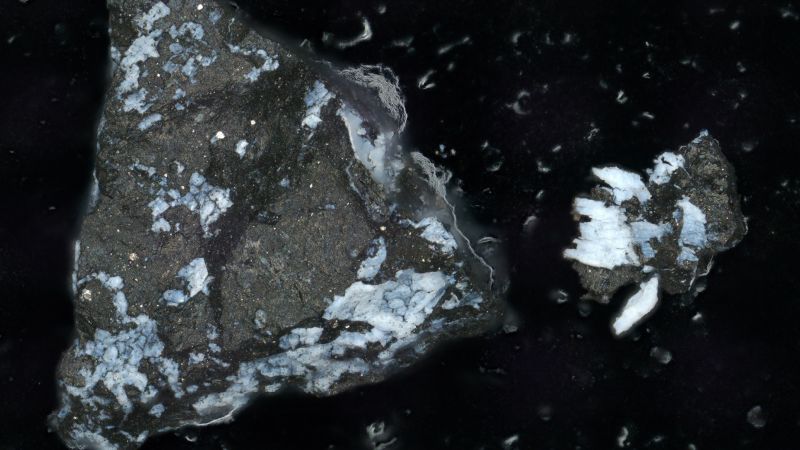Sign up for CNN’s Wonder Theory science newsletter. Explore the universe with news of fascinating discoveries, scientific breakthroughs and more.
CNN
—
Early analysis of a sample collected from the asteroid Bennu suggests the space rock had an unexpectedly water-rich past — and may have even split off from an ancient ocean world.
NASA’s OSIRIS-REx mission retrieved the pristine 4.3-ounce (121.6-gram) sample from the near-Earth asteroid in 2020 and returned it to Earth last September.
Since then, scientists have been analyzing the asteroid’s rocks and dust to see what secrets they might hold about the asteroid’s composition and whether it could have delivered the building blocks for life on Earth. Asteroids also intrigue scientists because they are leftovers from the formation of the solar system.
An initial examination of part of the sample, shared in October, suggested the asteroid contained a large amount of carbon.
During a new analysis of the sample, the team found that Bennu’s dust is rich in carbon, nitrogen and organic compounds, all of which helped form the solar system. These ingredients are also essential for life as we understand it, and can help scientists better understand how Earth-like planets develop.
A study describing the findings appeared Wednesday in the journal Meteoritics & Planetary Science.
“OSIRIS-REx gave us exactly what we hoped for: a large pristine sample of an asteroid rich in nitrogen and carbon from a once-wet world,” said study co-author Jason Dworkin, OSIRIS-REx project scientist at Goddard Space Flight Center of NASA in Greenbelt, Md., in a statement.
The biggest surprise was the discovery of magnesium-sodium phosphate in the sample, which remote sensing initially missed when OSIRIS-REx, or the Origins, Spectral Interpretation, Resource Identification and Security — Regolith Explorer mission, orbited Bennu.
Magnesium sodium phosphate is a compound that can dissolve in water and serves as a component of biochemistry for life.
Lauretta & Connolly et al. (2024)/Meteoritics and Planetary Sciences
A microscopic image shows a dark particle of Bennu, about a millimeter long, with a crust of bright phosphate.
It is possible that the asteroid broke away from a small, primitive ocean world that no longer exists in our solar system, the researchers said.
The asteroid sample is largely composed of clay minerals, including serpentine, making the sample strikingly similar to rocks found in Earth’s mid-ocean ridges. These ridges are where material from the mantle, the layer below the Earth’s surface, meets water.
A similar phosphate was found in a sample from the Ryugu asteroid collected by the Japan Aerospace Exploration Agency’s Hayabusa2 mission and returned to Earth in December 2020. But the compound from the Bennu sample is purer and has larger grains.
“The presence and state of phosphates, along with other elements and compounds on Bennu, suggest a watery past for the asteroid,” said lead study author Dante Lauretta, OSIRIS-REx principal investigator and Regents Professor at the University of Arizona, Tucson. in a statement. “Bennu could potentially have once been part of a wetter world. However, this hypothesis requires further investigation.
The rocks collected from Bennu represent a time capsule of the early days of the Solar System, dating back more than 4.5 billion years.
Erika Blumenfeld/Joseph Ebersold/NASA
Rocks and dust were collected from asteroid Bennu and returned to Earth by the OSIRIS-REx mission.
“The sample we brought back is the largest reservoir of unaltered asteroid material on Earth right now,” Lauretta said.
Astronomers believe that space rocks such as asteroids and comets may have served as ancient messengers to our solar system.
“This means that asteroids like this may have played a key role in delivering water and the building blocks of life to Earth,” said study co-author Nick Timms, a member of the OSIRIS-REx Sample Analysis team and associate professor in the School of Earth and planet of Curtin University Sciences, in a statement.
If these smaller rocky bodies carried water, minerals and other elements and slammed into Earth as it formed billions of years ago, they could have helped usher in life on our planet.
“These findings highlight the importance of collecting and studying material from asteroids like Bennu — especially low-density material that normally burns up upon entering Earth’s atmosphere,” Lauretta said. “This material holds the key to unraveling the complex processes of solar system formation and the chemistry of prebiotics that could have contributed to the emergence of life on Earth.”
The wealth of material collected from the asteroid means that more laboratories around the world will receive their own pieces of the sample for research.
“The Bennu samples are tantalizingly beautiful alien rocks,” study co-author Harold Connelly Jr., OSIRIS-REx mission scientist and chair of the Department of Geology at Rowan University’s School of Earth and Environment in Glassboro, N.J., said in a statement. “Each week, analysis by the OSIRIS-REx sample analysis team provides new and sometimes surprising discoveries that help place important constraints on the origin and evolution of Earth-like planets.”



